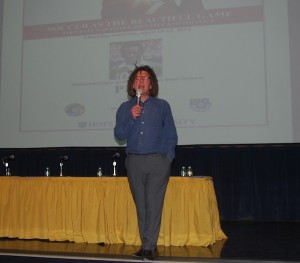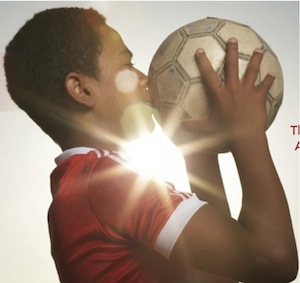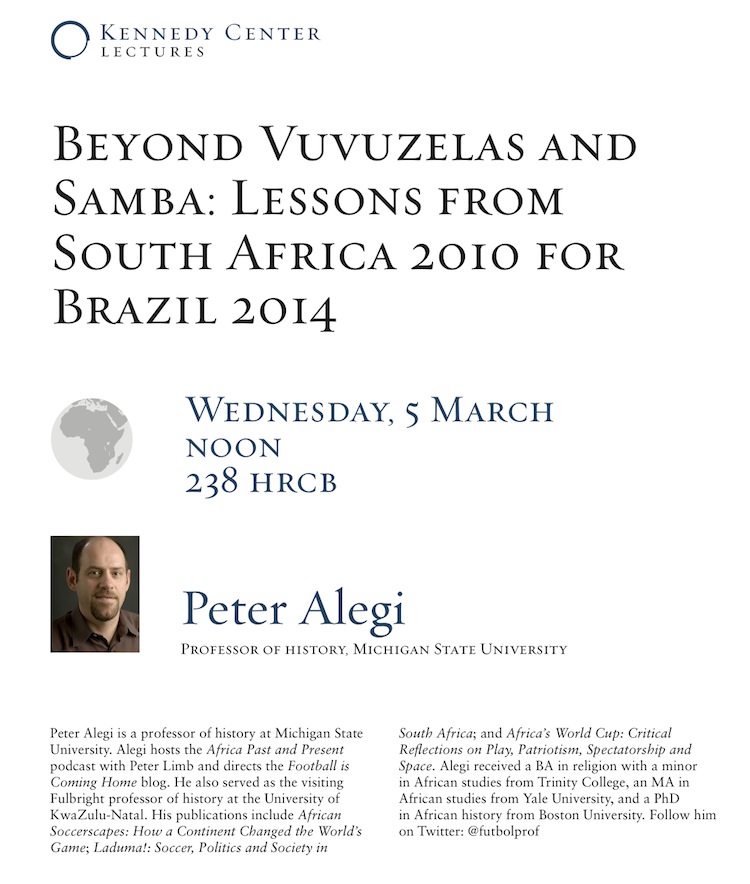I was recently interviewed by BBC Brasil‘s João Fellet and asked to compare the hosting of the 2010 World Cup in South Africa with the preparations for the 2014 World Cup in Brazil. Below is the Portuguese text of what transpired [translate] and a link to read the full article.
15 May 2014
BBC Brasil – Quatro anos depois da Copa de 2010, o que ficou do torneio para os sul-africanos?
Peter Alegi – Há um tipo de nostalgia por aquele período, por aquela sensação de unidade, solidariedade, de estar no centro do mundo. Os estrangeiros que foram para a Copa perceberam que os estereótipos negativos sobre a África do Sul não eram verdadeiros, e isso ainda faz o país se sentir bem. As emoções de um carnaval como a Copa são difíceis de bater.
BBC Brasil – Houve outros legados?
Alegi – O legado emocional foi importante de diferentes maneiras. Ele fez as pessoas sentirem um senso de unidade num país ainda muito dividido quanto a raças, classes e gêneros. Nos estádios sul-africanos, as pessoas cantam o hino abraçadas ou de mãos dadas, como nas igrejas. Num país onde o povo não tem muitas oportunidades de estar junto, a mágica do nacionalismo explodiu de uma maneira positiva.
Isso aconteceu só 16 anos após o apartheid. Sediar um evento bem sucedido fez com que os sul-africanos se sentissem muito orgulhosos.
O torneio também despertou sentimentos de panafricanismo. Por um ou dois meses, os sul-africanos se sentiram parte do continente africano. Isso foi encorajador, levando em conta os problemas do país com a xenofobia.

To read full article click here.
Author: Peter Alegi
Guest Post by Hikabwa Chipande (@HikabwaChipande)
 LUSAKA—Zambia is mourning football radio commentator Dennis Liwewe, who died on April 22, 2014, at the age of 78.
LUSAKA—Zambia is mourning football radio commentator Dennis Liwewe, who died on April 22, 2014, at the age of 78.
Liwewe caught the soccer fever on the Copperbelt in the late 1950s and 1960s, an era that led to the emergence of great players such as Samuel “Zoom” Ndlovu, John “Ginger” Pensulo and Kenny Banda. He became the first black football commentator in the early 1960s before Zambia’s independence. Liwewe’s passionate radio broadcasts made him a household name among ordinary Zambians. At a time when there was no television, Liwewe’s enthusiastic and absorbing descriptions of matches helped popularize the game across the country.
By the mid 1970s, he was known as a prominent football announcer in neighboring countries such as Tanzania, Malawi, Zimbabwe and Botswana. When Zambia reached the final of the 1974 African Cup of Nations finals in Cairo (which Chipolopolo lost to Zaire [now DR Congo]), the Egyptian weekly magazine Al-Musawar labeled Dennis Liwewe the greatest football commentator south of the Sahara. He drew favorable comparisons with the famous Egyptian radio and television broadcaster Mohamed Latif. (Latif had played for Egypt’s national team in the 1930s, then became a referee in the 1940s, before going on to earn the nickname “Sheikh of Commentators” in the 1950s.)
From the 1960s to the early 1990s, football on the radio was synonymous with Dennis Liwewe. His emotionally loaded calls made listeners of all ages in towns and villages around the country visualize what was happening in a stadium far away. He could estimate and explain all free-kick angles, distances to the goal, and the speed of the ball in a vivid and unmistakable voice. He had that distinctive ability to carry listeners with him, bringing enjoyment to their lives and even making them proud to be modern Zambians. It was not uncommon to hear both young and old people reciting and imitating his soccer commentaries, a kind of oral literature. No wonder Zambians felt that broadcasters who did not announce like Liwewe were just not good enough.
Even after the introduction of the Mwembeshi satellites and television broadcasts in 1974, Liwewe’s radio work remained popular. It was common for soccer fans to watch live matches on television with the volume turned down to listen to Liwewe on the radio. Many fans also went to Independence Stadium in Lusaka carrying two-band radios so they would not miss Liwewe’s entertaining narration. My good friend Mtoniswa Banda reminded me that another reason why fans carried radios to the stadium was because Liwewe often exaggerated or made up his play-by-play commentary. Even when the action was dull and distant, he could narrate it as if it were only a few inches from the goalposts! Other Zambian supporters also note that Liwewe became too commercial in his old age, to the point that he demanded to be paid in cash for an interview about the history of the game.
Aside from his radio work, Liwewe was employed by the Mining Mirror as a sports reporter for the Nchanga Consolidated Mines in Chingola. Subsequently, he rose to the position of Director of Public Relations of the Zambia Consolidated Copper Mines (ZCCM) before retiring in 1985.
Dennis Liwewe’s name in Zambia evokes memories of young people in urban townships and rural villages assembling makeshift radios, repairing (or buying) new ones, putting their old batteries out in the sun hoping to get enough power to listen to their favorite football announcer. History will show that here in south-central Africa his voice, passion, and imagination were not only admired, but loved, like the beautiful game itself.
Hofstra Soccer Conference Round-up
For as long as I can remember, soccer in the United States has been referred to as the “sport of the future.” Last week’s “Soccer as a Beautiful Game” international conference at Hofstra University buried this notion once and for all. Hofstra history professors Stan Pugliese and Brenda Elsey did a marvelous job organizing the global conclave.
 I arrived at the largest fútbological congress ever held in the U.S. just in time to hear David Goldblatt’s keynote address. Expecting a brilliant presentation based on his new book on Brazilian futebol, Goldblatt surprised many of us by delivering a democratic populist manifesto for the transformation of the world’s game. Goldblatt’s passionate speech for reform appealed to the suffrage of ordinary fans. (Click here and here to read more about this talk.)
I arrived at the largest fútbological congress ever held in the U.S. just in time to hear David Goldblatt’s keynote address. Expecting a brilliant presentation based on his new book on Brazilian futebol, Goldblatt surprised many of us by delivering a democratic populist manifesto for the transformation of the world’s game. Goldblatt’s passionate speech for reform appealed to the suffrage of ordinary fans. (Click here and here to read more about this talk.)
Energized by Goldblatt’s provocative address, I had to choose which of several enticing but concurrent panels to attend. As a historian, I decided to privilege sessions with historians, Global South topics, and presentations by Football Scholars Forum members. Much like football radio broadcasts of the pre-satellite TV era, many of us kept track of the action unfolding in other panels via the active Twitter back channel (#HUsoccer @HofstraSocConf).
The Soccer Conclave
 There may not be any white smoke coming out of the soccer conclave this week at Hofstra University in New York, but little else will be missing from an unprecedented fútbological event featuring presentations by more than 100 scholars, journalists, authors, coaches, and the King of Soccer himself: Pelé.
There may not be any white smoke coming out of the soccer conclave this week at Hofstra University in New York, but little else will be missing from an unprecedented fútbological event featuring presentations by more than 100 scholars, journalists, authors, coaches, and the King of Soccer himself: Pelé.
Historians Brenda Elsey and Stanislao Pugliese are the presiding cardinals of Soccer as the Beautiful Game: Football’s Artistry, Identity and Politics , an international conference hosted by the Hofstra Cultural Center and the Hofstra Department of History. The gathering begins on Thursday, April 10, with concurrent panels, an opening ceremony, and two keynote addresses by David Goldblatt (“Brazil: The Curious Rise of the Futebol Nation”) and Jennifer Doyle (“Imagining a World Without a World Cup: An Abolitionist Perspective).
Friday’s menu serves up a plethora of panels on a dizzying range of topics and a ceremony honoring Pelé with the conferral of an honorary degree. Saturday’s focus is on journalists, coaches, philanthropy round-tables, followed by a concluding plenary session, and . . . a pickup game on the New York Cosmos home ground! (Note to self: remember to pack turf shoes.)
I’ll be presenting a paper comparing World Cup 2010 in South Africa to World Cup 2014 in Brazil (click here to listen to an earlier version of this talk) and also participating in the Football Scholars Forum on academic vs. journalistic writing about soccer (click here to watch my pre-conference video blog and here to read the other five posts by my fabulous co-panelists).
This is my video blog contribution to the Football Scholars Forum roundtable taking place on Saturday, April 12, 2014, at the global fútbological conclave known as the Soccer as the Beautiful Game conference at Hofstra University in New York.
These pre-conference blog posts are intended to launch the discussion about points of overlap and tension in the soccer writing of journalists and academics. Roundtable participants will share their insights on sources and methodologies, topics, audience, market logic vs. academic logic, and the role of digital tools in writing and dissemination.
The rest of the roundtable team is composed of Simon Kuper (Financial Times), Brenda Elsey (historian, Hofstra U.) Alex Galarza (Michigan State U.), John Foot (U. Bristol), and Grant Wahl (Sports Illustrated). To read their posts visit: http://footballscholars.org

Sunday’s clásico was made for Ray Hudson’s commentary: like a “hair dryer in a hot tub” to use his magisterial description of Iniesta’s opening goal. I was happy with the outcome since I’ve had a soft spot for Barça for a long, long time. It dates back to my older brother in 1977 (or thereabouts) taking me to see Sandro Ciotti’s Il Profeta del Gol—a film about Cruyff with jaw-dropping goals from his azulgrana days. In honor of the Dutch genius, I even wore number 14 in high school and college back when I daydreamed about walking out of the tunnel at Camp Nou to take on Real Madrid.
Given all that, it’s the perfect time to review Sid Lowe’s Fear and Loathing in La Liga: Barcelona vs Real Madrid for today’s Football Scholars Forum.
Lowe, as readers of this blog probably know, is a noted fútbol journalist who writes about Spanish football for The Guardian and other major media outlets. He is also a rare sports reporter with a PhD (in History from the University of Sheffield in 2008 with a thesis on “The Juventud de Acción Popular in Spain, 1932-1937”). For a long time the biggest game in the world was not called el clásico but the derbi (p. 18). This book is a gold mine of such futbological facts and statistics. But the most revealing part of the journey, at least for me, came from its analysis and contextualization of the rivalry’s social and political dynamics.
The author’s academic training and sensibility is brought to bear on Fear and Loathing in La Liga in a number of ways. First, the chronological structure of the book. Second, the rich and diverse sources include government documents, minutes of club meetings, newspaper archives, newsreels, and many oral interviews with elderly protagonists, famous players, and club directors. (Regrettably, the commercial publisher decided to present the book without citations, probably for fear of alienating general readers.) Third, the book situates the fútbol rivalry within the larger context of a changing Spain. Fourth, it eagerly and ably goes beyond simple binaries that simplify the rivalry to just Spain vs. Catalonia, or in Lowe’s words: “Madrid fascists; Barça civil war losers. Madrid civil war victors and repressors; Barça left, Madrid right; Barça good, Madrid bad” (p. 12).
Lowe deploys the historian’s literary device of the potted biography to both complicate the facile dichotomy and to humanize his story. Two brilliant early chapters, for instance, focus on Barça and Madrid presidents during the civil war: Josep Sunyol (“The Martyr President”) and Rafael Sánchez Guerra (“The Forgotten President”). Having examined the historical evidence, Lowe debunks part of the political mythology of Barcelona. He reminds us that Madrid was where the civil war was fought, not Barcelona and argues persuasively that Franco’s forces murdered Sunyol not because he was Barça’s president “but because he accidentally crossed the front line and represented the Republic.” The story of Madrid’s president during the war, Rafael Sánchez Guerra, “a democrat, a liberal . . . committed to the Republic” (p. 39) arrested and tried by the Franco regime, serves as a useful counterpoint to the better known role of Santiago Bernabeu, the right-wing patriarch of Real Madrid during the Franco era.
The 1950s, the book shows, were a golden era for both the clubs and the rivalry itself. With the construction of Bernabeu stadium and Camp Nou, Barça and Madrid had grandiose stages for the performances of their newly arrived superstars: László Kubala (Hungary) and Alfredo Di Stéfano (Argentina), respectively. Camp Nou was the “House that László Built” (see pp. 97, 102-03) and his team’s wonderful success at the time motivated Bernabeu to sign Di Stefano. One of the book’s revelations, based on fascinating hard evidence, is the extent to which Barça’s dithering and doubt, as much as pressure from the Franco regime, led Di Stefano to Madrid. This was a crucial episode in the making of the rivalry as the Blond Arrow’s Dream Team (Puskas, Gento, Kopa, Del Sol, Santamaria . . .) went on to win the first five European Cups!
After Barcelona knocked Madrid out of the 1960-61 European Cup, the rivalry entered a “dark era” that ended with the arrival of Johan Cruyff on the eve of the Franco regime’s demise. The long 1960s are remembered for Real Madrid becoming cultural ambassadors of the dictatorship (though players had little choice in this) as well as for the infamous Copa del Generalissimo quarterfinal of 1970 when referee José Guruceta gifted visiting Madrid a penalty that eliminated the hosts. Guruceta’s match report describes 30,000 cushions thrown on to the pitch; his name, Lowe writes, “became Catalan shorthand for every referee in Spain, shorthand for injustice. For some, he had become shorthand for the football authorities, for Real Madrid and for the dictatorship” (p. 211).
The second half of the book opens with Johan Cruyff’s explosive impact at the Camp Nou in 1973-74. Cruyff’s debut coincided with the appearance of Barca’s slogan “mes que un club” (“More than a club”, now trademarked), which the book notes “did not feel entirely coincidental, football, politics and culture converging” (p. 232). Madrid’s response to the Cruyff-ication of Barca came in the 1980s with the Quinta del Buitre, which succeeded in resurrecting Real’s reputation but failed to win back the trophy that most defines the club: the European Cup.
The final third of the book covers the period from the 1990s to the present. It focuses on how and why Barcelona and Madrid came to dominate European football after 1998. This part is written in a markedly more journalistic style and is less original in its analysis. It is always more difficult for historians to write about contemporary events and avid readers have benefited from English-language books by Phil Ball and Jimmy Burns, among others. Last but not least, the satellite and Internet revolution has made it possible for many of us to closely follow the clásico’s recent history, on and off the pitch. Still, the 406-page book saves some juicy insights for the very end as it considers the impact of the Galacticos, the Special One, the cantera vs. cartera approaches to developing young players (training them vs. buying them), as well as how Spain’s international success has changed both the Barcelona vs. Real Madrid rivalry and fans’ sense of nationhood.
With our memories of Barcelona’s operatic 4-3 comeback victory at the Bernabeu on Sunday still fresh and raw, let us not give in too readily to melancholy or nostalgia. As the closing passage of Fear and Loathing in La Liga puts it: “Real Madrid and Barcelona FC will meet again and when they do the cast will be the most impressive in the game, tickets will sell out in hours and millions will gather in front of television screens across the world, more than for any other club match anywhere. And on the morning of the game they will still be there, clutching flowers, pleading for victory. Once more into the fray. Life in ninety minutes” (p. 409).
Beyond Vuvuzelas and Samba
 Listen to “Beyond Vuvuzelas and Samba: Lessons from South Africa 2010 for Brazil 2014,” a lecture I delivered at Brigham Young University’s David M. Kennedy Center for International Studies on March 5, 2014.
Listen to “Beyond Vuvuzelas and Samba: Lessons from South Africa 2010 for Brazil 2014,” a lecture I delivered at Brigham Young University’s David M. Kennedy Center for International Studies on March 5, 2014.
The talk analyzes the political, economic, and cultural dynamics of the 2010 FIFA World Cup in South Africa and its similarities to the upcoming 2014 FIFA World Cup in Brazil.
Click here to watch the video.